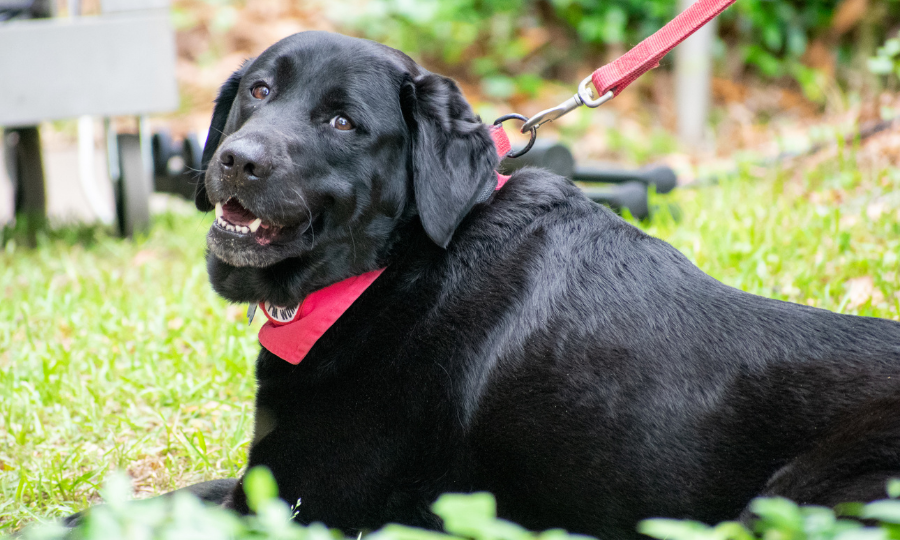It’s an old adage that a dog is man’s best friend. In Paul Ruby’s case, it goes beyond that: his dog, Roland, is not only his best friend, but also a valued member of his care team.
Service dogs can be life-changing for people with Parkinson’s. Depending on your needs, they can help with exercise, vestibular problems, depression, freezing, falling, and many more physical and emotional symptoms. However, the journey to finding a service dog isn’t always straightforward, as Paul shares in his story below.
What inspired you to find a service dog?
In 2018, I saw a blog post in a Davis Phinney Foundation newsletter about the benefits of service dogs for people with Parkinson’s, which encouraged me to start the journey toward finding a service dog for myself.
What did the process of adopting Roland look like?
After realizing that there are hundreds of organizations that train service dogs for people with many different needs, I decided I should involve an expert. I got in touch with a social worker who helped me research various options near me. Unfortunately, the application process is not regulated on a state or federal level. We found that there was significant variation in price: some organizations (for example, for qualified veterans) provide fully trained dogs at no cost, but the average cost for most people is between $20,000 and $60,000. The extensive training process is a big part of why it can be so expensive. While many organizations specialize their training for specific needs, like PTSD, autism, blindness, or mobility, there are no standardized training protocols. Therefore, it was important for us to confirm that the organization had experience training dogs to assist with my specific Parkinson’s needs.
What are some challenges you have faced along the way, and how have you overcome them?
The wait for a dog can be long and frustrating. I initially applied to several organizations and ended up putting down a deposit at a for-cost organization called SIT Service Dogs. Though I was eventually approved nine months later by a no-cost group, I had become very comfortable with SIT and had invested enough money that I decided to stick with them. The waiting period can be challenging, especially because you must be careful not to get attached to a dog before they have completed training and passed their tests. I made that mistake, and it caused a lot of disappointment as well as a delay in my timeline. However, I knew I wanted to stick with the process, and I’m grateful I did. Good training is important, but matching the right dog with their new partner is just as, if not more, critical.
 What does Roland help you with, and how do you involve him into your everyday life?
What does Roland help you with, and how do you involve him into your everyday life?
With very few exceptions, Roland is with me 24/7. We go to the grocery store, physical therapy, restaurants, bowling alleys… you name it, he’s there with me. He even sleeps in our bed! He knows close to 50 commands, but his primary function is to prevent me from falling. He keeps me very active: our walks together are getting me in better shape and improving my mobility, and I get out of the house much more these days. However, while his first priority is my safety, he also impacts my emotional wellbeing. Roland has undoubtedly reduced my stress, and the impact on my independence cannot be overestimated. Knowing that Roland is keeping me safe has also reduced the stress of being a care partner for my wife, Linda, and has allowed her more time to do things on her own.
What is your advice to other people with Parkinson’s who are considering adopting a service dog?
Although service dogs may quickly integrate themselves into your family (like Roland did with ours), it is important to remember that they are not pets in the traditional sense. They require ongoing training, and when they are “on the clock,” their focus needs to be completely on keeping their person safe. If you’re thinking about adopting a service dog, you need to plan on always having your companion with you, from work to the doctor’s office to vacations. You should also be prepared for a long waiting period and potentially high costs. That said, Roland has changed my life. I am so grateful we found each other and for the happiness, independence, and mobility he provides me. He joined our family over the holidays in late 2021, and other than a cure for Parkinson’s, I can’t think of a better gift than Roland.
Learn More
Want to learn more about how service dogs can help people with Parkinson’s live well? Explore general information on service dogs and Parkinson’s, or watch an interview with Lisa Skandali, MCs, on service dogs for people with Parkinson’s and Lewy body dementia. You can also read about Brian’s journey to find a service dog, from making the right match to training Dempsey himself.




